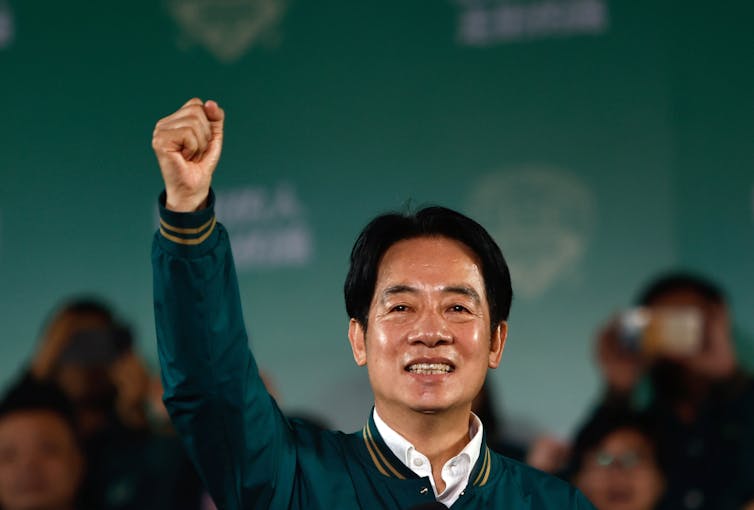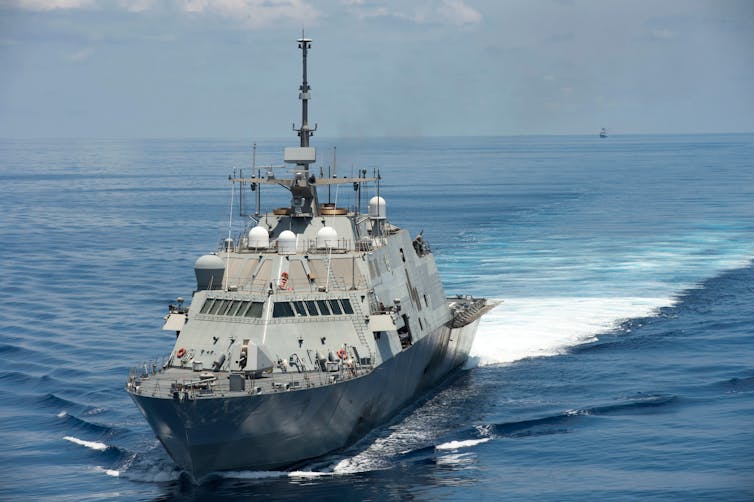Taiwan elected Lai Ching-te, also known as William Lai, to be its next president on January 13. His election marks the continuation of a government that promotes an independent Taiwan.
Just two days later, the Pacific nation of Nauru severed ties with Taiwan and transferred its diplomatic allegiance to Beijing.
More recently, on January 27, Tuvalu’s pro-Taiwan prime minister, Kausea Natano, lost his seat in the nation’s general election. Natano’s finance minister, Seve Paeniu, who is aiming for the prime ministership himself, was returned to his seat. In his campaign, Paeniu pledged to review Tuvalu’s relationships with China and Taiwan.
These examples indicate China’s growing influence in the south Pacific, a region that the world’s major powers are competing for influence over. But why is the region significant? And how are these major powers exerting their influence there?

Daniel Ceng/EPA
Preventing recognition of Taiwan
Taiwan has been governed independently since 1949. But Beijing believes it should be reunited with the rest of China. It is not an option for states to diplomatically recognise both China and Taiwan – China forces them to choose.
For decades, the Chinese government has used a combination of carrots and sticks to pressure such states into transferring diplomatic recognition from Taiwan to China.
China has, for example, imposed significant political, diplomatic and economic sanctions on countries that continue to formally recognise Taiwan. In 2022, China curbed imports from Lithuania to punish the country for allowing Taiwan to open a de facto embassy in the country.
But China also offers states – and their governing elites – economic and political incentives for withdrawing diplomatic recognition of Taiwan. It has, in the past, used its influence in the UN and other international organisations to block assistance or elect specific people to international positions.
Nauru’s change of diplomatic position, and the political debate unfolding in Tuvulu, should be understood as part of China’s longstanding effort to prevent and reduce recognition of Taiwan as a sovereign state.
But they are a significant step forward for China. Nauru has a leading position in the Pacific Islands Forum – the main political decision-making body for the region – so the country’s change of stance could lead to wider formal diplomatic changes in the south Pacific.
China, of course, has legitimate economic and political interests in the south Pacific too. It is a vital export market for natural resources from Pacific island states and is a key source of incoming tourism. According to Chinese statistics, total trade volume between China and Pacific island states grew from US$153 million (£121 million) to US$5.3 billion (£4.2 billion) between 1992 and 2021.
Competing for influence
Nauru’s decision is another diplomatic setback for Taiwan, which is now formally recognised by just 11 countries. However, this is not in itself a serious concern for the US, Australia and their allies.
They all formally recognise China, while at the same time maintaining close, informal links with Taiwan. Their focus is on trying to limit the depth of Chinese political and economic influence over Pacific island states and elsewhere in the Asia-Pacific region. The US is concerned that growing Chinese political influence may ultimately result in it enjoying significant military presence in the region.
The Pacific region encompasses the US state of Hawaii, multiple US territories, and is also home to several crucial US military bases. So, the US has made an effort to enhance its diplomatic relations in the region by providing financial support for initiatives around climate change adaption, sustainable fishing and economic growth.
However, increased tension between China and the west over the past decade has made it increasingly challenging to reign in Chinese influence. China has been asserting its primacy in and around Taiwan in the South China Sea, and has increasingly exerted military pressure.
China’s struggle for influence in the region now also includes taking opportunities to challenge previously undisputed western security dominance in the south Pacific. In 2022, China put forward a proposal for a diplomatic, economic and security agreement with the region. The agreement was, however, later abandoned due to resistance from some Pacific island nations at the urging of the US and Australia.

Stocktrek Images, Inc. / Alamy Stock Photo
US strategy in the south Pacific
When president, Donald Trump launched a number of deals with Pacific islands including Nauru, Marshall Islands, Solomon Islands, Palau and Micronesia. However, Trump’s strategy for a “free and open Indo-Pacific” had limited success. This was not only due to his confrontational posture towards China, but also to his threatening and protectionist “America first” rhetoric.
Joe Biden’s comparatively measured diplomacy has seen more success. In 2022, the Biden administration announced its “Pacific partnership strategy”.
The initiative included a commitment of US$810 million in development aid across the Pacific island region. And in May 2023, the US secretary of state, Antony Blinken, stated that he would work with Congress to provide over US$7.2 billion to support the region.
Since then, the US has recognised the Cook Islands and Niue as independent, sovereign nations, increased its diplomatic footprint in the region and has committed strongly to work with the Pacific Islands Forum to promote a “democratic, resilient and prosperous Pacific islands region”.
The shift of diplomatic ties from Taiwan to China does not mean that Pacific island nations want to reduce their ties with the west. But the US, Australia and their allies will need to invest a lot more in diplomatic, economic and security assistance if they want to counter China’s growing influence there.
